LINCOLN — Today, the Nebraska Department of Transportation (NDOT) released data that shows a 29 percent decrease in March statewide traffic volumes compared to the 2016-2018 three year average. NDOT will publish weekly updates to estimate the impact COVID-19 is having on vehicle traffic volumes across Nebraska.
Percent Difference in Weekly Traffic Volume March 2020 compared to 2016-2018 average:
|
|
Rural Highways |
I-80 West of Lincoln |
Omaha Streets & Highways |
Lincoln Streets & Highways |
I-80 Lincoln to Iowa, I-180, I-680, I-480 |
Remaining Small Urban Streets & Highways |
Statewide Total |
|
March 1-7 |
4 |
-9 |
3 |
4 |
3 |
-1 |
2 |
|
March 8-14 |
-4 |
-4 |
-5 |
-3 |
-6 |
-5 |
-4 |
|
March 15-21 |
-17 |
-10 |
-26 |
-20 |
-25 |
-17 |
-19 |
|
March 22-28 |
-24 |
-36 |
-28 |
-32 |
-41 |
-22 |
-29 |
Traffic volumes fluctuate greatly depending on variables like weather and construction. Travelers tend to take to the road more in the summer while freight traffic tends to stay fairly steady year round.
“The traffic data comparison is one tool for helping us understand how COVID-19 is impacting Nebraska,” said NDOT Director Kyle Schneweis. “While we are seeing freight traffic stay at near normal levels, a 29 percent decrease in statewide traffic volume has impacts on how NDOT manages our transportation system. We’ll continue to analyze the data to understand impacts and social trends.”
The March data compares 2020’s traffic to the historical three year (2016-18) average daily traffic for each day of the week for that month and then averages the difference in traffic for each week by category.
Data for 2019 was excluded due to the impacts of flooding on highways. For example, March 15-21 is calculated by finding the difference in March 15, 2020 vs. the historical average Sunday traffic for March, March 16, 2020 vs. the historic average Monday in March, etc. Then each day is averaged together to get a weekly average change in traffic.
The column descriptions are as follows:
- Rural Highway are all non-interstate roads in areas under 5,000 population.
- Omaha Streets & Highways include all non-interstate roads in Douglas and Sarpy counties.
- Lincoln Streets & Highways include all non-interstate roads in Lancaster County.
- Remaining Small Urban Streets & Highways are all roads in cities with over 5,000 population outside of Douglas, Sarpy, and Lancaster counties. (This includes I-129).
- Statewide Total is a weighted average of all categories.
The NDOT maintains a system of 67 continuous traffic counters statewide. These are often called automatic traffic recorders (ATRs). These counters collect traffic volume and classification data 24 hours per day, seven days a week. Data is then relayed to NDOT twice per week.
For more information/data about ATRs and links to the Annual ATR and February 2020 reports:
https://dot.nebraska.gov/media/3811/annual-traffic-count-data.pdf







